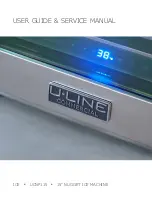
GB
51 / 81
The appliance automatically mixes and kneads the dough until proper consistence is
reached. When the last kneading cycle is completed, the bread maker heats to an optimum
temperature to rise the dough. Then, the appliance automatically sets temperature and
time for bread baking. Then the appliance turns one hour keeping warm program; if you
require no keeping warm program, press the
START/PAUSE/STOP
button for about 3
seconds to finish the program.
End of the programmed stages
After the programme is finished, pull out the bread pan
C
, and place it bottom up on
a thermally resistant surface (for example a cutting board). If the bread is stuck to the
pan move the kneading shaft a few times back and forth until the loaf is released. If the
kneading hook is left in the loaf, you can take it out easily with the tool
E
. Then, let the
bread cold down. Use electric slicer or a special toothed blade knife for slicing the bread.
Store remaining bread in a plastic bag or a utensil. You can store the bread for up to three
days at room temperature. If longer storage of the bread is needed, wrap it in the plastic
bag or utensil and store it in a freezer. Store for max 5 days. Whereas the homemade
bread does not contain any preservatives, its shelf life is not generally longer than the
same of shop-purchased bread.
Note
Use suitable personal protective equipment (e.g. kitchen gloves) for handling the hot
baking pan, holder, hook etc. Do not use gross force on walls of the baking pan to
release finished bread!
VI. CLEANING AND MAINTENANCE
Clean cooled down appliance only and after every use!
Before the first use, we
recommend coating the baking pan and the kneading hook with heat resistant fat and
warm them in the baker for about 10 minutes. Clean (polish) the baking pan from the
fat using a paper napkin after cooling down. This is to protect the non-adhesive surface.
Repeat the procedure after some time, if required. Use a mild detergent for cleaning. Do
not use chemicals, gasoline, oven cleaners or abrasive or otherwise damaging detergents.
Use a dampen rag to remove all the ingredients and crumbs from the lid, housing and
baking space.
Before every other use, dry all parts and surface of the bread maker
thoroughly (e.g. moisture condensation).
Never soak the bread baker in water or fill
the baking space with water!
Wipe the outer areas of the baking pan with a dampen rag.
Use a detergent to clean inner areas of the pan. Clean the hook and shaft immediately
after use. If the hook are retained in the pan, it will be harder to remove them out. In this
case, fill the pan with hot water and let it standing for about 30 minutes. Then, remove the
kneading hook. Do not soak the baking pan in water for too long; rotation of shafts would
be impaired. The baking pan is coated by a non-adhesive coating. Do not use metal tools
with potential to scratch the surface. It is normal when the surface colour changes over
time. However, this change has no effect on the surface properties.
Storage
Ensure the bread maker is cold before storage. Store the bread maker in a safe and dry
place, out of the reach of children and incapacitated people.
Maintenance of a serious nature or maintenance which requires interference with the
internal parts of the appliance must be carried out by a professional service centre!
By failing to follow the instructions issued by the manufacturer, the right
to the warranty service will be invalidated!
















































